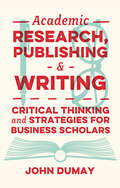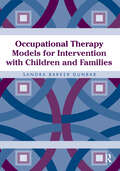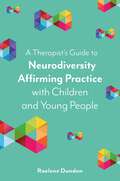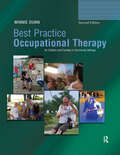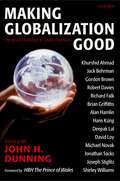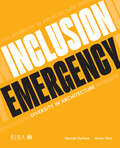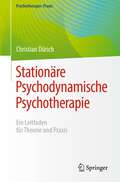- Table View
- List View
Academic Research, Publishing and Writing: Critical Thinking and Strategies for Business Scholars
by Dr John DumayAcademic Research, Publishing and Writing: Critical Thinking and Strategies for Business Scholars is designed for all scholars of business and management and outlines practical and proven ways of designing, developing, and executing impactful research and writing projects with a view to eventual publication. Chapters examine a wide range of essential scholarly practices in depth, including critical thinking and the IDEALS Framework, undertaking literature reviews, designing research for reliability, validity and generalisations, and understanding writing structure using IDEALS. John Dumay draws on experience and proven strategies to help the reader plot what they are going to research, what the potential impact of that research should be, what are the critical outlets for publishing are, and how should the research be written for the target audience. At the projects core is a strong focus on the importance on developing a strategy before starting the research which will increase the chances of publishing in high quality outlets, and surviving in the ‘publish or perish’ world.
Academic Research, Publishing and Writing: Critical Thinking and Strategies for Business Scholars
by Dr John DumayAcademic Research, Publishing and Writing: Critical Thinking and Strategies for Business Scholars is designed for all scholars of business and management and outlines practical and proven ways of designing, developing, and executing impactful research and writing projects with a view to eventual publication. Chapters examine a wide range of essential scholarly practices in depth, including critical thinking and the IDEALS Framework, undertaking literature reviews, designing research for reliability, validity and generalisations, and understanding writing structure using IDEALS. John Dumay draws on experience and proven strategies to help the reader plot what they are going to research, what the potential impact of that research should be, what are the critical outlets for publishing are, and how should the research be written for the target audience. At the projects core is a strong focus on the importance on developing a strategy before starting the research which will increase the chances of publishing in high quality outlets, and surviving in the ‘publish or perish’ world.
President Lyndon Johnson and Soviet Communism
by John DumbrellThis major new study fills a significant gap in the academic literature on the Cold War by considering President Lyndon Johnson’s policy towards the Soviet Union. The author examines the attitudes of Johnson and his leading advisers toward the Soviet leadership, taking into account the effects of Moscow’s growing splits with Beijing, the impact on US-Soviet relations of nuclear issues, the Vietnam War, and clashes over Cuba, the Middle East and Eastern Europe. The author’s research is based on detailed scrutiny of archives in Britain and the United States, as well as recently published document collections. His study also examines the President’s personal leadership qualities, his mistakes in Vietnam and his success as a peacemaker with Moscow. The book constitutes a major contribution to literature on President Johnson’s foreign policy ‘beyond Vietnam’.The book will be of interest to students of the Cold War, the Johnson Presidency and of US foreign relations.
Being There, but How?: On the Transformation of Presence in (Post-)Pandemic Times (Sozialtheorie)
by Sebastian Dümling Zhenwei WangIn phenomenological tradition, presence has been understood as fundamental for human experience: I experience the world as my lifeworld because I am present in this world. Even more, I experience myself as »I« only in the physical presence of the other. However, this concept of presence has become fragile through processes of medialization - especially in (post-)pandemic everyday life. Presence can no longer be experienced exclusively in physical proximity, but also digitally or virtually. With global case studies alongside theoretical discussions by both students as well as junior and senior researchers, the volume launches a conversation between social sciences and humanities on how this change affects human experience.
Occupational Therapy Models for Intervention with Children and Families
by Sandra DunbarOccupational Therapy Models for Intervention with Children and Families explores recent theoretical models that enable occupational therapists to practice and interact with families in a more holistic and occupation-centered manner. This comprehensive and dynamic text offers the latest information on viewing the broader contexts of environment and family in order to meet diverse occupational needs in a range of settings.Sandra Barker Dunbar presents a variety of case scenarios that feature culturally diverse populations and varying diagnoses of children with occupational needs. With contributions from 11 renowned leaders in occupational therapy, this comprehensive text is designed to increase awareness and understanding of theoretical models and their relationship to current occupational therapy practice with today’s children and families.Inside Occupational Therapy Models for Intervention with Children and Families, traditional frames of reference in pediatric practice are explored, including sensory integration and neurodevelopmental treatment. Some current theoretical models discussed include the Model of Human Occupation, the Person-Environment-Occupation model, the Ecology of Human Performance model, and the Occupational Adaptation model. The new Occupational Therapy Practice Framework is incorporated throughout the text.Employing a practical approach to this significant aspect of pediatric practice in occupational therapy, Occupational Therapy Models for Intervention with Children and Families is an invaluable tool for students at all curriculum levels.
Occupational Therapy Models for Intervention with Children and Families
by Sandra DunbarOccupational Therapy Models for Intervention with Children and Families explores recent theoretical models that enable occupational therapists to practice and interact with families in a more holistic and occupation-centered manner. This comprehensive and dynamic text offers the latest information on viewing the broader contexts of environment and family in order to meet diverse occupational needs in a range of settings.Sandra Barker Dunbar presents a variety of case scenarios that feature culturally diverse populations and varying diagnoses of children with occupational needs. With contributions from 11 renowned leaders in occupational therapy, this comprehensive text is designed to increase awareness and understanding of theoretical models and their relationship to current occupational therapy practice with today’s children and families.Inside Occupational Therapy Models for Intervention with Children and Families, traditional frames of reference in pediatric practice are explored, including sensory integration and neurodevelopmental treatment. Some current theoretical models discussed include the Model of Human Occupation, the Person-Environment-Occupation model, the Ecology of Human Performance model, and the Occupational Adaptation model. The new Occupational Therapy Practice Framework is incorporated throughout the text.Employing a practical approach to this significant aspect of pediatric practice in occupational therapy, Occupational Therapy Models for Intervention with Children and Families is an invaluable tool for students at all curriculum levels.
Preventive Cardiovascular Nursing: Resilience across the Lifespan for Optimal Cardiovascular Wellness
by Sandra B. Dunbar Lynne T. BraunThis book provides a comprehensive overview of essential concepts and evidence that guide the practice of contemporary preventive cardiovascular nursing. The sections incorporate a lifespan approach to cardiovascular wellness, and provide perspectives on sources of known and emerging cardiovascular risk factors as well as the spectrum of multidimensional factors including biological, behavioral, psychological and sociocultural influences on cardiovascular wellness, risk, and the evolution of cardiovascular conditions. Unique features address: 1) building resilience across the lifespan such that optimal cardiovascular wellness can be attained within multiple contexts of health states to increase a healthy lifespan and longevity; 2) behavior change skills for risk factor reduction; 3) risk factors and risk reduction approaches with special populations defined by gender, , age and aging, heath states, and health equity issues; and 4) high level roles for cardiovascular nurses as provider - risk assessor, communicator and care provider; educator, leader, patient and health advocate. Relevant case studies are included throughout to facilitate the application of the content. This book fills a gap in that there is no other book on preventive cardiovascular nursing care and roles , and it provides support for the nurse to lead relevant interdisciplinary teams. The book will empower nurses to build knowledge and skills for cardiovascular prevention and to provide leadership for optimal cardiovascular wellness for patients and communities.
An Occupational Perspective on Leadership: Theoretical and Practical Dimensions
by Sandra Dunbar Kristin WinstonAn Occupational Perspective on Leadership: Theoretical and Practical Dimensions, Third Edition is essential for occupational therapy students, practicing clinicians, and administrators. Building upon the 2 previous editions, Drs. Sandra Dunbar-Smalley and Kristin Winston provide an in-depth exploration of leadership theories alongside the application of occupational therapy theoretical models to leadership practice within the occupational therapy profession.The Third Edition includes new theoretical perspectives, case examples, and adapted reflection activities to further meet the needs of students and entry-level professionals. New chapters address:• Followership in the context of leadership• A systems approach to leadership• Shared leadership• Transforming health care with leaders for changeAn Occupational Perspective on Leadership: Theoretical and Practical Dimensions, Third Edition demonstrates the potential of occupational therapy leadership and encourages the next generation of students and clinicians to advance their understanding and application of occupational therapy and leadership theory for best practices.
An Occupational Perspective on Leadership: Theoretical and Practical Dimensions
by Sandra Dunbar Kristin WinstonAn Occupational Perspective on Leadership: Theoretical and Practical Dimensions, Third Edition is essential for occupational therapy students, practicing clinicians, and administrators. Building upon the 2 previous editions, Drs. Sandra Dunbar-Smalley and Kristin Winston provide an in-depth exploration of leadership theories alongside the application of occupational therapy theoretical models to leadership practice within the occupational therapy profession.The Third Edition includes new theoretical perspectives, case examples, and adapted reflection activities to further meet the needs of students and entry-level professionals. New chapters address:• Followership in the context of leadership• A systems approach to leadership• Shared leadership• Transforming health care with leaders for changeAn Occupational Perspective on Leadership: Theoretical and Practical Dimensions, Third Edition demonstrates the potential of occupational therapy leadership and encourages the next generation of students and clinicians to advance their understanding and application of occupational therapy and leadership theory for best practices.
Cultivating a Sustainable Core: A Framework Integrating Body, Mind, and Breath into Musculoskeletal Rehabilitation
by Elizabeth DuncansonIntegrating holistic treatments into movement and wellness practices, Cultivating a Sustainable Core is an indispensable guide for initiating and organizing assessments and interventions for patients with multiple injuries.Drawing on clinical research and years of experience in physical therapy, sports medicine, athletic conditioning and yoga, this book explains why the author first addresses the body's dynamic central motor stability and efficiency when treating clients. Cultivating a Sustainable Core demonstrates how the application of breathing, mindful movement and cognitive reframing practices can counteract the effects of detrimental postural and movement habits, breath and thought patterns, pain, and chronic stress. Extensive research backs up the author's discoveries while illustrations and user-friendly practices bring the theory and practical techniques to life.
The Parents' Guide to Managing Anxiety in Children with Autism
by Raelene DundonThis guide for parents is a complete introduction to autism and anxiety. Drawing on the author's clinical experience working with children and their families, it provides parents and carers with everything they need to know to help support their child. It covers the basics such as what anxiety is, how it manifests behaviourally and why it is common in autism, before presenting CBT-informed practical strategies for managing a common range of anxieties: separation, social, performance, phobias, and generalised anxiety. It also has chapters dedicated to related behaviours including Pathological Demand Avoidance (PDA) and advice on managing meltdowns.This is a clear, concise and practical guide that answers any questions that parents and carers might have about anxiety and provides support strategies to help children with autism manage a range of anxieties.
A Therapist’s Guide to Neurodiversity Affirming Practice with Children and Young People
by Raelene DundonIn this honest and practical guide, autistic therapist Raelene Dundon explores and demystifies how neurodiversity affirming principles can be easily applied to therapeutic practice.Covering essential considerations for working with neurodivergent clients such as presuming competence, promoting autonomy and respecting communication styles, and providing advice on the best affirming approaches in therapy including how to accommodate sensory needs and encourage self-advocacy, Raelene provides easy-to-implement ways to make your practice inclusive and empowering for neurodivergent children and young people.The deficit model is out. It's time to become neurodiversity affirming.
The Lavender Companion: Enjoy the Aroma, Flavor, and Health Benefits of This Classic Herb
by Jessica Dunham Terry Barlin VesciA celebration of lavender featuring stunning photographs; favorite recipes for the kitchen, pantry, and body care products; along with fascinating lore and gardening guidance from a destination lavender farm. Lavender has long been a favorite herb with its amazing, resinous fragrance; calming qualities; and unique flavor for seasoning food. This lavishly photographed celebration of the beloved herb, written by an acclaimed lavender farmer and cooking instructor, is brimming over with inspiration and ideas for bringing the fragrance and flavor of lavender into daily life. The book profiles the most popular lavender varieties and their recommended uses, along with the history, lore, and traditional medicinal uses. More than 40 recipes showcase lavender in delicious dishes from the kitchen as well homemade craft and body products. Tips for success with lavender in the garden complete this perfect gift for every lavender lover.
Our Universe: An Astronomer's Guide (Pelican Books)
by Jo DunkleyA world-renowned astrophysicist takes us through the huge, unfolding history of the universeThe night sky is an endless source of wonder and mystery. For thousands of years it has been at the heart of scientific and philosophical inquiry, from the first star catalogues etched into ancient Mesopotamian clay tablets to the metres-wide telescopes constructed in Chile's Atacama Desert today. On a clear night it is hard not to look up and pick out familiar constellations, and to think of the visionary minds who pioneered our understanding of what lies beyond.In this thrilling new guide to our Universe and how it works, Professor of Astrophysics Jo Dunkley reveals how it only becomes more beautiful and exciting the more we discover about it. With warmth and clarity, Dunkley takes us from the very basics - why the Earth orbits the Sun, and how our Moon works - right up to massive, strange phenomena like superclusters, quasars, and the geometry of spacetime. As she does so, Dunkley unfurls the history of humankind's heroic journey to understand the history and structure of the cosmos, revealing the extraordinary, little-known stories of astronomy pioneers including Williamina Fleming, Vera Rubin and Jocelyn Bell Burnell. Illuminating and uplifting, this is your essential guide to the biggest subject of all.
Qualitative Social Research: Critical Methods for Social Change
by Priscilla Dunk-West Kate SaxtonThis text provides an easy-to-read introduction to qualitative research methods in social work, taking into account contemporary contexts and social conditions.Drawing from a range of social work perspectives, it allows the reader to make the connection between social work values, theory and specific research methods and approaches.Comprised of 11 chapters, it covers overarching epistemological perspectives and knowledge construction; designing a research question; research design and methods; data collection and analysis; research ethics and dissemination; and impact and research translation. Highlighting social work’s unique commitment to social justice, it positions social work research as embedded in the profession’s values.As the first book to comprehensively connect social work values and emancipatory frameworks, including decolonising practices, with research methods, it shows readers the connection between social work theory and choices in relation to ethical research design.This book is suitable for use on all BSW and MSW research modules across Australia and New Zealand as well as social work courses across the UK.
Qualitative Social Research: Critical Methods for Social Change
by Priscilla Dunk-West Kate SaxtonThis text provides an easy-to-read introduction to qualitative research methods in social work, taking into account contemporary contexts and social conditions.Drawing from a range of social work perspectives, it allows the reader to make the connection between social work values, theory and specific research methods and approaches.Comprised of 11 chapters, it covers overarching epistemological perspectives and knowledge construction; designing a research question; research design and methods; data collection and analysis; research ethics and dissemination; and impact and research translation. Highlighting social work’s unique commitment to social justice, it positions social work research as embedded in the profession’s values.As the first book to comprehensively connect social work values and emancipatory frameworks, including decolonising practices, with research methods, it shows readers the connection between social work theory and choices in relation to ethical research design.This book is suitable for use on all BSW and MSW research modules across Australia and New Zealand as well as social work courses across the UK.
Computational Construction Grammar: A Usage-Based Approach (Elements in Cognitive Linguistics)
by null Jonathan DunnThis Element introduces a usage-based computational approach to Construction Grammar that draws on techniques from natural language processing and unsupervised machine learning. This work explores how to represent constructions, how to learn constructions from a corpus, and how to arrange the constructions in a grammar as a network. From a theoretical perspective, this Element examines how construction grammars emerge from usage alone as complex systems, with slot-constraints learned at the same time that constructions are learned. From a practical perspective, this work is accompanied by a Python package which enables linguists to incorporate construction grammars into their own corpus-based work. The computational experiments in this Element are important for testing the learnability, variability, and confirmability of Construction Grammar as a theory of language. All code examples will leverage the cloud computing platform Code Ocean to guide readers through implementation of these algorithms.
Best Practice Occupational Therapy for Children and Families in Community Settings
by Winnie DunnAs the occupational therapy profession concerns itself with how people occupy their time during daily life, it is critical for occupational therapists who serve children to understand how to apply their knowledge and skills within the complex and varied environments of the community.A core text for over 10 years, Best Practice Occupational Therapy for Children and Families in Community Settings, Second Edition by Dr. Winnie Dunn provides a clear insight into how to conceive, design, implement, and evaluate services that reflect core principles.Best Practice Occupational Therapy for Children and Families in Community Settings, Second Edition provides the most current information about providing services within community settings, with material addressing early intervention, early childhood, school-age services, and transitions.The context of this text is rooted in best practice principles from interdisciplinary literature and illustrates how occupational therapy professionals implement those principles in their everyday practices.New Features of the Second Edition: Updated assessments, evidence, and appendices Case studies that illustrate the implementation of ideas in a practice situation Worksheets that outline each step in the occupational therapy process from what to include to how to provide rationale for team members, families, and consumers Tables and inserts that summarize key points Information regarding state and federal legislation to guide the occupational therapists in how to negotiate for best practice services within parameters of regulations Integrated throughout the text is the American Occupational Therapy Association’s Occupational Therapy Practice Framework Additional on-line resources that are available with new book purchases Included with the text are online supplemental materials for faculty use in the classroom.Best Practice Occupational Therapy for Children and Families in Community Settings, Second Edition contains many suggestions about how to practice the skills needed for evidence-based practice, making this the perfect resource for occupational therapy students, faculty, and practitioners who serve children and families.
Best Practice Occupational Therapy for Children and Families in Community Settings
by Winnie DunnAs the occupational therapy profession concerns itself with how people occupy their time during daily life, it is critical for occupational therapists who serve children to understand how to apply their knowledge and skills within the complex and varied environments of the community.A core text for over 10 years, Best Practice Occupational Therapy for Children and Families in Community Settings, Second Edition by Dr. Winnie Dunn provides a clear insight into how to conceive, design, implement, and evaluate services that reflect core principles.Best Practice Occupational Therapy for Children and Families in Community Settings, Second Edition provides the most current information about providing services within community settings, with material addressing early intervention, early childhood, school-age services, and transitions.The context of this text is rooted in best practice principles from interdisciplinary literature and illustrates how occupational therapy professionals implement those principles in their everyday practices.New Features of the Second Edition: Updated assessments, evidence, and appendices Case studies that illustrate the implementation of ideas in a practice situation Worksheets that outline each step in the occupational therapy process from what to include to how to provide rationale for team members, families, and consumers Tables and inserts that summarize key points Information regarding state and federal legislation to guide the occupational therapists in how to negotiate for best practice services within parameters of regulations Integrated throughout the text is the American Occupational Therapy Association’s Occupational Therapy Practice Framework Additional on-line resources that are available with new book purchases Included with the text are online supplemental materials for faculty use in the classroom.Best Practice Occupational Therapy for Children and Families in Community Settings, Second Edition contains many suggestions about how to practice the skills needed for evidence-based practice, making this the perfect resource for occupational therapy students, faculty, and practitioners who serve children and families.
Bringing Evidence Into Everyday Practice: Practical Strategies for Healthcare Professionals
by Winnie Dunn Rachel ProffittBringing Evidence Into Everyday Practice: Practical Strategies for Health Care Professionals, Second Edition provides a step-by-step process for learning how to use literature to inform quality practices in an accessible workbook format. Bringing Evidence Into Everyday Practice simplifies analyzing research through repetition of core strategies and the systematic introduction of increasingly complex techniques for interpreting literature. Students, early career professionals, and interdisciplinary teams alike can build a common language and structure for selecting and evaluating evidence to incorporate into their practices. What’s included in Bringing Evidence Into Everyday Practice:• Worksheets to guide learning, available in print and as writable PDFs online• Ample opportunities to repeat and practice skills• Summary articles, emerging practices, and data collection• How to search databases, examine quality features, and identify the parts of a research article• A library of articles that learners can access from their libraries or the internetIncluded with the text are online supplemental materials for faculty use in the classroom. Bringing Evidence Into Everyday Practice: Practical Strategies for Health Care Professionals, Second Edition walks readers through each step of reviewing articles in the literature—providing them with a scaffolding of understanding how to evaluate and incorporate evidence into their practice.
Bringing Evidence Into Everyday Practice: Practical Strategies for Healthcare Professionals
by Winnie Dunn Rachel ProffittBringing Evidence Into Everyday Practice: Practical Strategies for Health Care Professionals, Second Edition provides a step-by-step process for learning how to use literature to inform quality practices in an accessible workbook format. Bringing Evidence Into Everyday Practice simplifies analyzing research through repetition of core strategies and the systematic introduction of increasingly complex techniques for interpreting literature. Students, early career professionals, and interdisciplinary teams alike can build a common language and structure for selecting and evaluating evidence to incorporate into their practices. What’s included in Bringing Evidence Into Everyday Practice:• Worksheets to guide learning, available in print and as writable PDFs online• Ample opportunities to repeat and practice skills• Summary articles, emerging practices, and data collection• How to search databases, examine quality features, and identify the parts of a research article• A library of articles that learners can access from their libraries or the internetIncluded with the text are online supplemental materials for faculty use in the classroom. Bringing Evidence Into Everyday Practice: Practical Strategies for Health Care Professionals, Second Edition walks readers through each step of reviewing articles in the literature—providing them with a scaffolding of understanding how to evaluate and incorporate evidence into their practice.
Making Globalization Good: The Moral Challenges of Global Capitalism
by John H. DunningGordon Brown, Jonathan Sacks, Joseph Stiglitz, Hans Kung, Shirley Williams, and a dozen other leading thinkers in international business and ethics identify the pressing moral issues which global capitalism must answer. How can we develop a global economic architecture which is efficient, morally acceptable, geographically inclusive, and sustainable over time? If global capitalism — arguably the most efficient wealth creating system currently known to man — is to be both economically viable and socially acceptable, each of its four constituent institutions (markets, governments, supranational agencies, and civil society) must not only be technically competent, but also be buttressed and challenged by a strong moral ethos. The book includes contributions from leading academics, politicians, and moralists. Recognizing that solutions will not come from any one quarter, and that any serious discussion of a just and equitable system will touch on questions of ethics and faith, the book approaches the issues from a range of different disciplines and forums.
Inclusion Emergency: Diversity in architecture
by Hannah Durham Grace ChoiArchitecture is at a tipping point. Voices of the under-represented have been increasing in volume and are agitated for change. If we don’t collectively listen, re-adjust and change our future outlook, we limit the potential relevance of the profession in today’s society and, ultimately, the places we create. Capturing insight from leading voices in the profession, this book encourages understanding, reflection and addresses critical questions, providing steps towards meaningful change. It will help those who are under-represented to find role models, context and tools & to be confident, supported and valued. Building understanding for those more privileged to acknowledge bias, it will enable mitigation and awareness of the issues to encourage meaningful action. This is a call for change. Now.
Stationäre Psychodynamische Psychotherapie: Ein Leitfaden für Theorie und Praxis (Psychotherapie: Praxis)
by Christian DürichIn diesem Buch erfahren Ärzte, Psychologen und therapeutisches Klinikpersonal, wie die Psychodynamische Psychotherapie im Rahmen eines integrativen Behandlungskonzepts stationär als eigenständiges Therapieverfahren umgesetzt wird: Ausgehend von intersubjektiven und gruppenanalytischen Entwicklungen aus Tiefenpsychologie und Psychoanalyse wird dargestellt, wie Übertragungs- und Gegenübertragungsanalyse als beziehungsreflexiver Teamprozess angewendet werden können, um konfliktneurotische, strukturelle und Traumafolgestörungen fundiert psychotherapeutisch zu behandeln. Aus dem Inhalt: Mit Fokus auf die Operationalisierte Psychodynamische Diagnostik werden psychische und psychosomatische Krankheitsbilder von Angst- bis Zwangsstörungen mit ihren Psychodynamiken und Beziehungsaspekten inklusive Fallbeispiele zum Nachschlagen zusammengefasst. Ergänzende Perspektiven bieten die störungsorientierte Integration psychotherapeutischer Methoden wie z. B. Stabilisations- oder Konfrontationstechniken sowie die Bezugnahme auf aktuelle Leitlinien. Ausführungen zu Indikationsstellung, Evaluation und Evidenz runden den Überblick ab. Über den Autor: Dr. med. Christian Dürich, Facharzt für Psychosomatische Medizin und Psychotherapie und Psychoanalytiker/Gruppenanalytiker, ist Chefarzt der Psychosomatik am Katholischen Krankenhaus Hagen. Er ist weiterbildungsermächtigter Arzt der Ärztekammer Westfalen-Lippe und Vorsitzender der Westfälischen Arbeitsgemeinschaft für Psychosomatik, Psychotherapie und Psychoanalyse.
